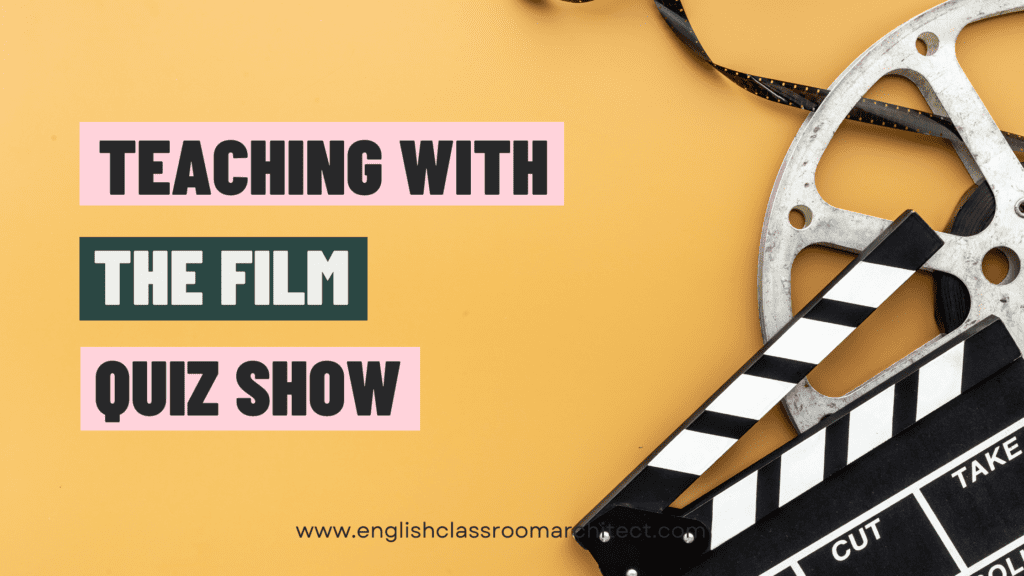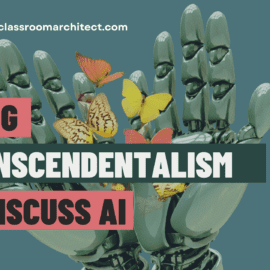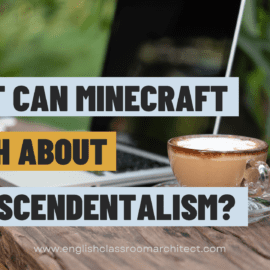It’s referred to as The Golden Age of Television. Radio is losing popularity and now families sit there around the television in the early evening. It was in the 1950s that network television’s nascent marketing took shape.
The film Quiz Show documents the early years of television, specifically America’s fascination with quiz shows, and the scandal that rocked the early medium when producers fixed the results of popular shows in order to ensure popularity for their show sponsors.
Teachers may be hesitant to teaching with film. But not only does teaching with film provide context for the time for Fahrenheit 451 and The Crucible, it also sheds light on America’s complicated relationship with knowledge and learning, providing opportunities for rich discussion in high school English classrooms.
The film itself is not only ripe for curriculum connections, it is a great movie as a standalone. Among many honors, it won a Golden Globe for Best Film – Drama, and Robert Redford won a Golden Globe for Best Director. The cast is star studded, and students will likely recognize Ralph Finnes who they know as Lord Valdemort. While nothing will please everyone, this is a film the vast majority of my students found engaging.
I love when texts can serve multiple functions, and I found that teaching with film, specifically the The Quiz Show, is one that really packs a punch. I have used this opportunity for teaching with film to provide historical context, deepen contextual understanding of America’s relationship with knowledge, help students synthesize text for Socratic Seminars, and help make thematic connections between the 1950s and today.

Table of Contents
Teaching with Film to Explore Parallel Themes in Quiz Show, The Crucible, and Fahrenheit 451
I initially planned to use the film Quiz Show simply for the historical and cultural context it could provide to the texts we were reading that were written during the 1950s: The Crucible, Raisin in the Sun, and Fahrenheit 451. But, as I started to plan how I was going to implement my ideas for teaching with film, I realized the conceptual pairings were quite deep, and could even connect to The Great Gatsby, as well. Across these works, the interplay between power structures and the dissemination of knowledge forms a recurring motif – the multifaceted ways in which those in control wield their influence over information, shaping perceptions and determining truth.
In a world where books are banned and intellectualism is suppressed, the manipulation of knowledge becomes increasingly important for us to address. In Fahrenheit 451, the oppressive government maintains control by erasing history, altering narratives, and substituting substance with superficiality. What makes this all the more terrible is that the society of the novel got to this point because people gradually gave up their willingness to think critically. As we guide our students through the bleak landscape of Fahrenheit 451, we explore the implications of a society devoid of critical thinking and the perilous consequences of a society that seeks to stifle enlightenment.
The Crucible, set against the backdrop of the Salem witch trials, unveils the danger of unchecked authority. The manipulation of knowledge, in this case through false accusations, not only tears at the fabric of a community but reveals how those in power can exploit fear and hysteria to maintain control. Through the lives of the characters we help our students to understand information can be weaponized to serve ulterior motives.
Moving from the pages of literature to the silver screen, teaching with the film The Quiz Show thrusts us into the realm of reality television and media manipulation. Here, the contestants’ quest for knowledge is manipulated by unseen hands seeking to construct an image of success. The power structures at play are hidden beneath the surface, shaping the narrative for entertainment value and ratings. As we peel back the layers of deception, we confront the disconcerting reality of how media can influence perceptions, reinforcing the notion that even in the pursuit of knowledge, manipulation can obscure the truth.
Across these narratives, the common thread is the potent connection between power and the control of knowledge. Whether through censorship, accusation, or media manipulation, we’re confronted with the sobering reality that those who hold authority possess the capacity to mold reality itself.
Examining the American Relationship with Knowledge
America has a complicated relationship with knowledge. On one hand, we celebrate success related to knowledge. On the other hand, culture communicates that people can be “too smart for their own good” and in popular culture book smarts are often looked down upon and labeled outcasts. Americans are often skeptical of people that are too bookish. As a result, the pursuit of knowledge is often central in American literature.
When I taught this last I really went down a rabbit hole. My students were completing a video essay about a 1950s topic for their summative and they needed to incorporate a film of their choice, The Crucible, and Fahrenheit 451. To have a sample and to troubleshoot the process, I completed the assignment myself. My project incorporated the film The Quiz Show. We watched it as a class, and I felt like my project would reinforce and deepen their previous conversations and assignments. I chose the topic because I knew there would be content to work with, but as I worked through the assignment, I came to realize the deep connection among these three texts.
As I delved into the historical and cultural factors shaping the American knowledge culture, a luminous figure stepped onto the stage—Mortimer Adler. An eminent philosopher, educator, and early proponent of the Great Books movement, Adler’s influence resonated deeply in my exploration. His philosophical tenets advocating for the pursuit of knowledge and critical thinking found a home with the Van Doren family, who were close friends and confidants of Adler.
I had not made the connection until I was into my research, but I already had knowledge of Charles Van Doren through his work with Adler as I have read their book How to Read a Book, which suggests “how” is through active and critical connection with the content. The book is a direct reaction to the fallout of The Great Books movement. Adler wanted people to engage with these “great books,” but in reality they often became an educational shortcut. Visually, people could appear learned by displaying novels associated with deep thinking, even if they had not actually read the tomes they displayed.
As Charles navigated the fallout of the quiz show scandal, his affiliation with Adler served as a shield, offering a degree of insulation that his counterpart, Herbert Stempel, did not enjoy. Adler was Chairman of the Board of Encyclopedia Britannica, not coincidentally the place where Charles Van Doren got a job after he lost his job at Columbia following his Congressional subcommittee testimony and admission that he participated in the rigging of the show, Twenty-One.
Intriguingly, this connection amplifies the narrative of The Quiz Show. Charles Van Doren’s association with Adler not only highlights his intellectual prowess but also provides a glimpse into the power structures at play.
This juxtaposition of both affinity to and reppelance of knowledge mirrors the themes woven into Fahrenheit 451 and The Crucible, where power and influence over knowledge become instruments that can either shield or subjugate.
Through the prism of Adler’s influence, we discern the intricate web of connections that shape the American knowledge culture. From the suppression of books in Fahrenheit 451 to the machinations of power in The Crucible and The Quiz Show, the interplay between knowledge, authority, and society’s dynamics becomes a tapestry of exploration, urging us to unravel its intricacies and become architects of a more informed and discerning future.
Reflecting on the Relevance of “Quiz Show” in the Modern Era
By teaching with the film, students will see a clear connection between The Quiz Show and reality television. The manipulative tactics that emerge in the film’s game show scandal mirror the tactics often employed in reality TV, where narrative crafting and selective editing can skew perceptions for entertainment purposes.
While America shines as a knowledge superpower, we’ve developed a paradoxical relationship with education and learning. In our pursuit of individualism and free thought, we’ve sometimes downplayed the significance of education, even expressing skepticism towards intellectual pursuits. This blend of skepticism and pride creates a unique landscape—one where our students must traverse the contours of truth and falsehood with caution.
The Quiz Show might be a period piece, but its connections to truth, deception, and ethics still resonate loudly in our lives. From fake news to social media filters, our world is brimming with situations that make us question what’s real and what’s not. Teaching with the film provides opportunities for connecting these contemporary issues with the film’s themes, and we can empower our students to be critical thinkers and responsible consumers of information.
With the creation of the Internet, now everyone can put out content and have a voice. The voice can be built on strong, factual content, but it can also be made up of baseless information. Now it is not so simple to know what is valid or fake just by looking at it. Artificial intelligence and the growing possibility of deep fakes confounds this possibility.
In the ever-evolving landscape of information, where tweets (are they still called tweets now that Twitter is now called X?) become headlines and videos go viral before breakfast, our students are navigating a whirlwind of content like never before.
We must guide our students towards a deep understanding of the complexity of information, fostering the skills they need to dissect, evaluate, and discern the real from the fabricated. By nurturing these skills, we’re empowering a generation to question, analyze, and challenge.
Teaching with the film Quiz Show and Integration with The Crucible
Looking at The Quiz Show alongside Arthur Miller’s The Crucible, an interesting intersection of history and literature emerges. Through this juxtaposition, we offer our students a chance to peer into the historical contexts that underpin these works, unraveling the societal pressures that have shaped human behavior across different eras.
In The Quiz Show, set against the backdrop of the 1950s, the allure of television’s rising influence in American households exerts an undeniable pull. Just as the characters in The Crucible grapple with the societal pressures of the Salem witch trials, where conformity and maintaining appearances were paramount, the contestants and decision-makers in the film wrestle with their roles in an emerging media culture.
Teaching with the Film Quiz Show and Integration with Fahrenheit 451
In the digital age, where technology weaves a tapestry of connection and convenience, Fahrenheit 451 takes on new resonance. As we explore the role of media and technology in shaping knowledge, the parallels between Bradbury’s vision and contemporary realities come into focus. The omnipresence of screens, the inundation of information, and the manipulation of narratives mirror the all-encompassing technology depicted in the novel.
The cautionary echoes of Fahrenheit 451 reverberate beyond its fictional pages, urging us to scrutinize our own culture. By drawing parallels between Bradbury’s dystopian universe and contemporary society, we encourage our students to recognize warning signs that echo in our midst. The erosion of critical thinking, the proliferation of shallow entertainment, and the subversion of truth are threads that weave through both narratives.
While these parallels scream to us, our students may be too deep in the muck and mire to easily see how strong the connection between their lives and the text is. In a recent Socratic Seminar, several students admitted they did not actually read the text assignment for the day, but they did not see that their behavior was similar to what happened in Fahrenheit 451 that led to the dystopian society, but instead only railed on societies that censor knowledge seeing the dangers that lie in other countries. Students need to understand the impact their actions have on our knowledge culture and also recognize the consequences of complacency.
Teaching with the Film Quiz Show and Integration with The Great Gatsby
As we look into the root causes of the quiz show scandal, we see that television marketing drove the decisions of the producers. The decision to reduce Hebert Stempel with Charles Van Doren was one of optics, and their choice was done under the guise of viewership and their relationship with their sponsor, Geritol. Producers wanted America to continue to tune in, and they believed the polished academic Charles Van Doren had more draw than the previous winner, Herbert Stempel. By exploring this dynamic, Quiz Show explores the dynamics of class and ethnicity at play in the 1950s.
In The Great Gatsby, Jay Gatsby manipulates reality in an effort to present the perfect image of himself. Similar to the methods employed by quiz show producers in the 1950s, Jay Gatsby bends and breaks rules and laws in order to achieve the ultimate picture of success.
With this parallel, students can look into the role that media and marketing play in their perception of the truth.
Beyond Teaching with Film: Cultivating Critical Thinking and Media Literacy
- Engage in Socratic Seminars to encourage discussions on power dynamics, manipulation, and censorship, fostering open dialogue and diverse perspectives.
- Utilize Close Reading and Textual Analysis to explore key scenes, uncover layers of meaning, and identify motifs related to power and knowledge.
- Foster Reflective Writing to bridge personal experiences with themes of power, manipulation, and information, promoting personal growth and deeper connections.
- Develop Critical Media literacy through Media Analysis Projects that evaluate news sources, recognize bias, and draw parallels between media manipulation in texts and contemporary challenges.
- Facilitate Ethical Dilemma Discussions to encourage consideration of the ethical impact of knowledge on individuals and society, promoting conversations on responsibility, accountability, and knowledge dissemination.
- Promote Responsible Consumption by teaching students to navigate and evaluate information with discernment, empowering them to distinguish between reliable sources and disinformation.
Conclusion
By teaching with film, we infuse our pedagogy with the power to shape not only literary understanding but also the very foundations of intellectual engagement. By celebrating the achievements of the past, confronting the challenges of the present, and preparing for the uncharted territories of the future, we pave the way for a generation that thrives as critical thinkers, ethical consumers of information, and champions of knowledge culture.



